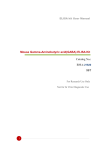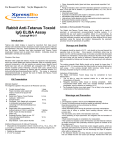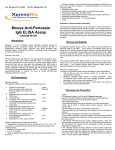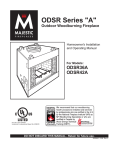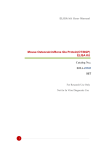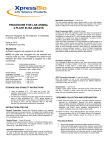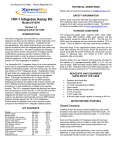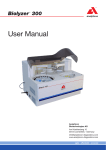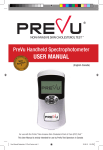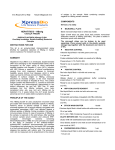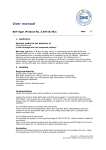Download SIV p27 Elisa Assay
Transcript
For Research Use Only Not for Diagnostic Use > > > > Latex gloves, safety glasses and other appropriate protective garments. Biohazard infectious waste containers. Safety pipetting devices for 1 mL or larger pipettes. Timer. Automatic, or Semi-automatic Processing SIV p27 Elisa Assay Catalog# SK845 Introduction Principle of the Assay Microtitration wells coated with murine anti-SIV p27 capture antibody, are exposed to test specimens, which may contain p27 reactive determinants. After an incubation period, unbound components in the test sample are washed away. Specifically bound p27 reactive determinants react with a mouse anti-SIV p27 conjugated with biotin during a second incubation period. Following a second wash cycle the biotinylated antibody is detected by the addition of a streptavidin HRP conjugate. Following a third wash cycle, specifically bound enzyme conjugate is detected by reaction with the substrate solution, tetramethylbenzidine (TMB). The assay is measured spectrophotometrically to indicate the level of p27 reactive determinants present in a sample. Kit Presentation Materials Supplied The reagents supplied in this pack are for Research use only. 1 2 3 4 5 6 7 8 Coated microwell strips. Plastic microtitration wells coated with anti-SIV p27 murine monoclonal antibody in foil pouch with desiccant. Positive p27 Control 100 ng/ml Lysis Buffer Detector antibody anti-SIV p27 conjugated to biotin Conjugate. Streptavidin conjugated to horseradish peroxidase enzyme containing 0.01% Bromonitrodioxane as preservative. Wash Buffer (20x concentrated). Tris buffered saline pH 7.8-8.0, containing 0.05% Tween 20. Must be diluted before use. Substrate Solution. Ready to use. Tetramethylbenzidine Stop Solution. 1 N H2SO4 1 plate (96 wells) 0.1 mL 6 mL 12 mL 12 mL 2 Bottles 60 mL 12 mL 12 mL Additional Requirements for Manual Processing > Disposable tip micropipettes to deliver volumes of 5 µL, 10 µL, 25 µL, 100 µL and 200 µL (multichannel pipette preferred for dispensing reagents into microtiter plates). > Distilled or deionized water. > 37 (±1)º C incubator. > Clean, disposable plastic/ glass test tubes, approximate capacities 5 mL and 10 mL. > Range of standard, clean volumetric laboratory glassware consisting of, at least, 15 mL and 100 mL beakers, 1 L graduated cylinder,1 mL, 5 mL, and 10 mL glass pipettes. > Absorbent paper towels. > Automatic microtitration plate washer or laboratory wash bottle. > Microtitration plate reader with 450 nm filter. The SIV p27 Assay may be used with a variety of automatic or semi-automatic processors/liquid handling systems. It is essential that any such system is qualified, before it is used routinely, by demonstrating that the SIV p27 Assay results obtained using the automatic processor are equivalent to those obtained for the same specimens using the manual test method. Subsequently the automatic processor should be periodically re-qualified. Storage and Stability All reagents should be stored at 2-8°C , and should not be used beyond the expiration date on the label. Once opened, microtitration strips may be stored at 2-8°C until the expiration date on the label, provided that desiccated conditions are maintained. Unused strips should be returned to their original foil pouch along with the sachet of desiccant. Opened pouches should be securely resealed by folding over the open end and securing it with adhesive tape. The working strength Wash Buffer should not be stored for longer than 3 weeks at 2-8°C. It is recommended that Wash Buffer be freshly diluted before each assay. If the working strength buffer becomes visibly cloudy or develops precipitate during the 3 weeks, do not use it. Indications of Deterioration The SIV p27 Assay may be considered to have deteriorated if: 1. The kit fails to meet the required criteria for a valid test (see 6.Interpretation of Results). 2. Reagents becoming visibly cloudy or develop precipitate. Note: Concentrated Wash buffer, when cold, normally develops crystalline precipitates, which re-dissolve on heating at 37°C. 3. The Substrate Solution turns dark blue. This is likely to be caused by chemical contamination of the Substrate Solution. Warnings and Precaution Safety 1. The reagents supplied in this kit are for Research use only. 2. Caution: All blood products should be treated as potentially infectious. Essential precautions can be summarized as follows: >Do not pipette by mouth. >Wear disposable gloves during all specimen and assay manipulations. >Avoid use of sharp or pointed liquid handling devices, which may puncture skin. >Do not smoke, eat or drink in the laboratory work area. >Avoid splashing of liquid specimens and reagents and the formation of aerosols. >Wash hands thoroughly on completion of a manipulation. >The Centers for Disease Control & Prevention and the National Institutes of Health recommend that potentially infectious agents be handled at the Bio safety Level 2. 3. The SIV p27 kits contain reagent systems, which are optimized and balanced for each kit lot. Do not interchange reagents from kits with different lot numbers. Do not interchange vial caps or stoppers either within or between kits. 4. The Substrate Solution and Stop Solution in this kit contain ingredients that can irritate the skin and cause eye damage. Handle them with care and wear suitable protective clothing and eye/face protection. In case of contact with skin or eyes, immediately flush the affected area with plenty of water. For eyes, obtain medical attention. Procedural This kit should be used in strict accordance with the instructions in the Package Insert. 2. Do not use SIV p27 Assay kits after the expiration date printed on the outer carton label. 3. Do not cross contaminate reagents. Always use fresh pipette tips when drawing from stock reagent bottles. 4. Always use clean, preferably disposable, glassware for all reagent preparation. 5. Allow foil bags to warm to room temperature before opening. This avoids condensation on the inner surface of the bag, which may contribute to a deterioration of coated strips intended for future use. 6. Reagents should be dispensed with the tip of the micropipettes touching the side of the well at a point about mid-section. Follow manufacturer's recommendations for automatic processors. 7. Always keep the upper surface of the microtitration strips free from excess fluid droplets. Reagents and buffer over-spill should be blotted dry on completion of the manipulation. 8. Do not allow the wells to completely dry during an assay. 9. Disposal or decontamination of fluid in the waste reservoir from either the plate washer or trap for vacuum line in the manual system should be in accordance with guidelines set forth in the Department of Labor, Occupational Safety and Health Administration, occupational exposure to blood-borne pathogens; final rule (29 CFR 1910,1030) FEDERAL REGISTER, pp. 64176-84177,12/6/91. 10. Automatic or semi-automatic EIA processors or liquid handling systems should be qualified specifically for use with SIV p27 Assay by demonstration of equivalence to the manual processing methods. 11. Consistent with good laboratory practice, it is recommended that all pipetting devices (manual or automatic), timers and thermometers are regularly calibrated according to the manufacturer's instructions. 12 Care must be taken to ensure that specimens are dispensed correctly to each test well. If a specimen is inadvertently not added to a well, the result for that well will be non-reactive, regardless of the actual result of the specimen. Preparation for the Assay 1. Method of Use Specimen Collection and Storage SIV p27 Assay is intended for use with tissue culture supernatants. The specimen should be tested as soon as possible. However, if the specimen needs storage, the specimens should be stored frozen at -20°C or below. Do not use self-defrosting freezers. Specimens that have been frozen and thawed should be thoroughly mixed before testing. Rinse Cycle Efficient rinsing to remove un-complexed components is a fundamental requirement of enzyme immunoassay procedures. The SIV p27 assay utilises three standard six-rinse cycles. Automatic plate washers may be used provided they meet the following criteria: 1 All wells are completely aspirated. 2. All wells are filled to the rim (350 µL) during the rinse cycle. 3. Wash Buffer is dispensed at a good flow rate. 4. The microtitration plate washer must be well maintained to prevent contamination from previous use. Manufacturer’s cleaning procedures must be followed diligently For each rinse cycle the machine should be set to six consecutive washes. On completion of the cycle, invert the microtitration plate and tap firmly on absorbent paper towels. Check for any residual Wash Buffer in the wells and blot dry the upper surface of the wells with a paper towel. Alternatively, the following manual system may be employed: 1. Aspirate well contents using a vacuum line fitted with a trap. 2. Fill all wells to the brim with Wash Buffer dispensed from a squeeze-type laboratory wash bottle. 3. Aspirate all wells. 4. Repeat steps 2 and 3, five times. 5. Invert the microtitration plate and tap firmly on absorbent paper towels. 1. Kit Positive Control 100 ng/ml Prepare working strength Positive Control by diluting 20ul of positive control into 980 ul (1:50 dilution) of uninoculated tissue culture media. This will give a final concentration of 2000 pg/ml. 2. Wash Buffer Prepare working-strength Wash Buffer by diluting 1 part concentrate with 19 parts of distilled or de-ionized water. If a kit is likely to be utilized over a period in excess of 4 weeks, then it is recommended that only enough stock concentrate be diluted sufficient for immediate needs. Each row of 8 wells may be adequately washed with 150 mL of working strength buffer. Qualitative Assay Procedure 1 Allow all reagents to reach room temperature (18-25°C). 2 The diluted positive control (2000pg/ml) and uninnoculated cell culture media (for use as a negative control) should be tested at least in duplicate in every assay. If a standard curve is to be run, the quantitative protocol should be used. 3 Select sufficient microtitration well strips to accommodate all test specimens,controls and reagent blank. Fit the strips into the holding frame. Label wells according to specimen identity using the letter/number cross-reference system moulded into the plastic frame. 4 Dispense 20ul of lysis buffer to each well. 5 Dispense 200 µL of each control and specimen into appropriate wells. Note: All controls and samples should be tested in duplicate. 6 Incubate at 37(±1)°C for 60 (±5) minutes. 7 Aspirate the contents of the wells and wash the microtitration plate as described in the Rinse Cycle section. 8 Pipette 100 µL of detector antibody into each well and incubate at 37(±1)°C for 60 (±5) minutes. 9 Aspirate the detector antibody from the wells and wash the microtitration plate as described in the Rinse Cycle section. 10 Pipette 100ul of Streptavidin HRP conjugate into each well and incubate at room temperature (18-25°C) for 30 (±5) minutes. 11 Aspirate the conjugate from the wells and wash the microtitration plate as described in the Rinse Cycle section. 12 Without delay, dispense 100 µL Substrate Solution into each well. A multichannel pipette should be used for best results. Leave at room temperature (18-25°C) protected from direct sunlight, for 30 (±2) minutes. 13 Stop the reaction by adding 100 µL of Stop Solution to each well including the reagent blank. The blue solution should change to a uniform yellow color. Ensure that the undersides of the wells are dry and that there are no air bubbles in the well contents. 14 Immediately after adding the Stop solution, read the absorbance values at 450 nm using a microtitration plate reader blanked on the negative control well. Quantitative Assay Procedure To test quantitatively, a standard curve should be prepared using tissue culture media as the diluent. First prepare the 2000pg/ml standard as above in step 1. Prepare four serial two fold dilutions to prepare 1000 pg/ml, 500pg/ml, 250 pg/ml and 125 pg/ml standards using the tissue culture media as diluent. Each standard plus an inoculated tissue culture control should be run in duplicate. Computer-Assisted Method: Computer assisted data reduction may be used to create the standard curve. Software providing a point to point curve fitting routine provides acceptable results. Interpretation of Results Qualitative Analysis The following criteria should be met for a valid assay: Assay validation The SIV p27 assay should be considered valid if: The negative control should be ≤ 0.10 The 1000 pg/ml control should be ≥0.60 The negative control should be ≤ 0.10 The 1000 pg/ml control should be ≥0.60 Quantitative Analysis Manual Method: The calibration curve can be constructed manually on linear graph paper by plotting the mean absorbance for each standard on the y-axis versus the concentration of the standard (value printed on vial) on the x-axis. Connect the points to produce a point to point curve. Do not force the line to be linear. The concentration of the specimens can be found directly from the standard curve Table 1. Example Data at 450nm. Sample 450 nm abs. Standard 1 (0 pg/mL) “ Standard 2 (125 pg/mL) “ Standard 3 (250 pg/mL) “ Standard 4 (500 pg/mL) “ Standard 5 (1000 pg/mL) “ Standard 6 (2000 pg/mL) “ 0.000 0.000 0.126 0.136 0.293 0.317 0.629 0.645 1.245 1.273 2.543 2.585 Specimen #1 “ Specimen #2 “ 0.328 0.338 1.196 1.232 Mean abs. pg/mL Procedure for Samples with SIV p27 assay values greater than the highest standard. Many tissue culture samples will have p27 values greater than the highest standard. In order to obtain accurate results for samples with SIV p27 assay values greater than the highest standard it is necessary to dilute and re-test the sample. Diluting the serum specimen 10-fold is recommended. For example: Make a 10-fold dilution by adding 0.1 mL of the initial specimen to 0.90 mL of tissue culture medium. Mix thoroughly and repeat the assay according to the Assay Procedure. Multiply the results by 10 to determine the correct SIV p27 assay values in the sample. 0.000 0.131 Limitations of Use 0.305 0.637 1.259 2.564 0.333 271 1.214 964 Note: This standard curve is only an example and should not be used to generate any results. 1. Assay values determined using assays from different manufacturers or different methods may not be used interchangeably. 2. Samples with very high p27 assay values levels may exhibit in a prozone effect. For this assay, antigen levels must be greater than 50,000 pg/mL before the assay gives erroneous results of less than 2000 pg/mL. 3. The assay cannot be used to quantitate samples with SIV p27 assay values greater than the highest standard without further serial dilution of the samples. See the Interpretation of Results section for directions on testing such samples. 4. The performance characteristics have not been established for any matrices other than tissue culture media. Performance Characteristics Analytical Sensitivity: To determine the sensitivity of the assay, the 0 standard was assayed 20 times. The minimal detectable level was calculated by adding two standard deviations to the mean absorbance for the 0 standard. The minimal detectable level is 25 pg/mL. Linearity: Four strongly reactive samples were serially two fold diluted and run on the assay. The values obtained were compared to the expected values by standard linear regression. The r values obtained ranged from 0.998 to 1.00. Precision: Four samples with different levels of activity were assayed ten times each on three different assays. The results are summarized in the following table. Precision Data Assay 1 (n = 10) Assay 2 (n = 10) Assay 3 (n = 10) InterAssay (n = 30) Mean (pg/mL) SD CV Mean (pg/mL) SD CV Mean (pg/mL) SD CV Mean (pg/mL) SD CV Sample 1 1606 82.3 5.13% 1749 44.5 2.54% 1761 69.7 3.97% 1706 96.8 5.67% Contact Information: Express Biotech International P.O. BOX 458 Thurmont, MD 21788 USA Tel: 301-228-2444 Fax: 301-560-6570 www.expressbiotech.com [email protected] Sample 2 527 41.0 7.79% 586 41.1 7.01% 577 54.8 9.50% 563 51.7 9.18% Sample 3 1110 50.4 4.54% 1207 41.4 3.43% 1309 135.1 10.3% 1209 117.6 9.73% Sample 4 308 29.8 9.70% 347 26.7 6.97% 450 41.8 9.28% 368 69.2 18.8%





